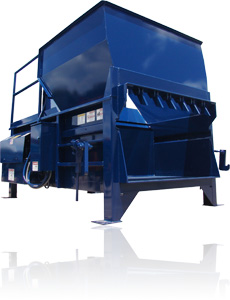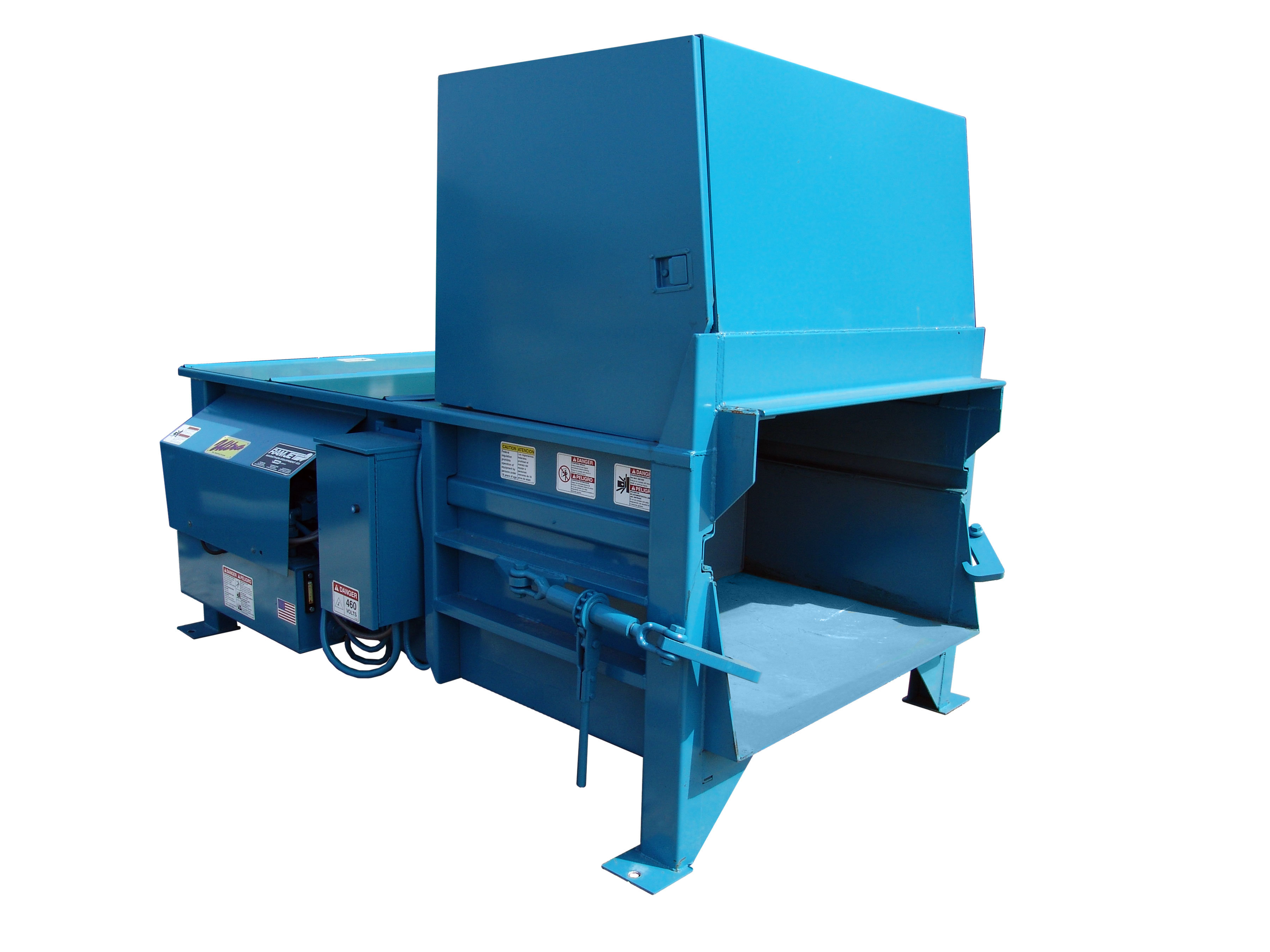A straightforward explanation of Industrial waste compaction equipment for industries
Wiki Article
Understanding the Various Uses Waste Devices in the Recycling Sector
The recycling market counts greatly on specialized waste equipment to optimize handling and recovery. Each tool, from shredders to balers, serves a distinct objective that boosts total performance. Comprehending these duties is vital for enhancing sustainability efforts. Commercial garbage compaction equipment. As modern technology developments, brand-new developments emerge, promising to change standard techniques. This evolution elevates important inquiries about the future of waste management and its influence on ecological conservation. What adjustments lie in advance for this vital sector?The Function of Shredders in Product Processing
Shredders play a critical duty in the reusing market by efficiently processing numerous kinds of waste materials. These makers are designed to minimize huge products, such as plastics, steels, and natural waste, into smaller sized, manageable pieces. This size reduction is vital for subsequent recycling procedures, as it permits less complicated handling and sorting. In enhancement to promoting recycling, shredders improve security by reducing the risk of injury related to taking care of large waste items.Moreover, shredders contribute to ecological sustainability by ensuring that materials are processed in a way that maximizes source healing. They can handle a diverse array of materials, making them flexible devices in waste management centers. The effective procedure of shredders not only enhances the reusing process yet also enhances the overall effectiveness of waste diversion efforts, promoting a round economic situation. Their significance in product processing can not be overemphasized, as they work as a fundamental step towards lasting waste administration practices.

Exactly How Balers Enhance Performance in Waste Administration
Balers significantly enhance effectiveness in waste administration by condensing numerous products into bales, which simplifies storage and transportation. By pressing recyclables such as cardboard, plastics, and metals, balers substantially decrease the quantity of waste. This compression not just takes full advantage of space in reusing facilities however additionally lessens the number of trips needed to transfer products, bring about reduced gas prices and reduced ecological effect.Balers contribute to improved security in waste management operations. Compact bundles are easier to deal with and stack, lowering the risk of crashes associated with loosened materials. The uniform dimension of bundles permits much more effective loading and unloading processes, enhancing procedures within recycling centers. Furthermore, balers can boost the total top quality of recyclables, as correctly compressed products are less most likely to be contaminated. Overall, balers play an essential duty in enhancing waste management methods, advertising sustainability in the recycling market.
Conveyor Systems: Simplifying the Recycling Process
Incorporating sophisticated equipment like balers greatly boosts waste administration procedures, however the performance of the recycling process is better improved via making use of conveyor systems. These systems play a crucial role in the smooth transport of products within reusing centers. By helping with the motion of numerous waste kinds, conveyor systems decrease manual handling and minimize the threat of contamination throughout the recycling process.Additionally, conveyor systems can be tailored to fit the Industrial waste compaction equipment special formats and functional requirements of reusing facilities. Their capacity to run constantly allows for a consistent circulation of materials, boosting efficiency and ensuring that processing and sorting equipment obtains a regular supply.
Outfitted with features like adjustable rates and automated controls, conveyor systems can maximize the flow of materials, substantially boosting total efficiency (Commercial garbage compaction equipment). Subsequently, these systems are crucial in modern recycling procedures, adding and enhancing processes to efficient waste management
Sorting Devices: The Key to Product Healing
Sorting equipments are vital components in the recycling industry, considerably improving the effectiveness of product recuperation. These makers play an essential role in the splitting up of numerous recyclable products, enabling a streamlined process that maximizes resource removal. By utilizing advanced modern technologies, such as optical sensors and air classifiers, arranging makers can determine and categorize products based on their weight, dimension, and make-up. This capacity guarantees that metals, plastics, and paper items are properly isolated, lessening contamination and boosting the quality of recycled result.The procedure of arranging machines considerably decreases the reliance on manual work, which can be both taxing and susceptible to mistakes - Commercial garbage compaction equipment. In addition, the automation offered by these equipments accelerates the total recycling process, bring about higher throughput and boosted functional performance. Subsequently, sorting devices are crucial in accomplishing sustainable waste management objectives, making it possible for the recycling sector to successfully recuperate important products while decreasing garbage dump dependency

Advancements in Waste Devices for a Sustainable Future
Recent developments in waste tools are driving the reusing sector toward a much more sustainable future. Technologies such as automated sorting systems, which utilize expert system and equipment learning, enhance efficiency by accurately identifying and dividing recyclables. This causes higher recovery rates and decreased contamination. Furthermore, advancements in compacting technology allow for more effective transportation of products, reducing carbon impacts during transportation.Developments in shredding tools boost the processing of complex products, making it possible for the recycling of items that were once regarded non-recyclable. The combination of renewable resource resources, like solar power, in waste processing centers better adds to sustainability goals. Furthermore, technologies in naturally degradable materials and waste-to-energy innovations are reshaping the landscape of waste management. Jointly, these innovations represent a transformative change within the recycling market, advertising not only environmental management yet likewise financial stability for future generations.
Regularly Asked Inquiries
What Kinds Of Materials Can Waste Tools Manage?
The types of materials waste devices can handle consist of plastics, steels, paper, glass, and organic waste. Each tools type is created for certain products, optimizing performance and performance in sorting and processing numerous waste streams.Exactly How Usually Should Waste Equipment Be Preserved?

Exist Security Interest In Utilizing Waste Equipment?
Security interest in using waste tools consist of prospective injuries from mechanical breakdowns, direct exposure to hazardous materials, and poor training. Correct upkeep, routine inspections, and employee education are important to mitigate these threats effectively in any setup.What Is the Typical Life Expectancy of Recycling Equipment?
The average lifespan of reusing devices normally ranges from 10 to two decades, relying on factors such as usage strength, upkeep methods, and technical developments, which can considerably influence durability and performance in time.Exactly How Is Waste Devices Powered in Recycling Facilities?
Waste devices in reusing facilities is typically powered by power, though some machines may use different power sources like all-natural gas or diesel. This power allows reliable handling and change of materials for reusing purposes.Shredders play a critical role in the reusing industry by successfully refining numerous kinds of waste materials. They can handle a varied array of products, making them versatile devices in waste management facilities. Balers significantly improve effectiveness in waste monitoring by condensing different products into bales, which streamlines storage space and transportation. The types of materials waste tools can manage include plastics, steels, paper, glass, and organic waste. Safety and security worries with using waste equipment include potential injuries from mechanical breakdowns, exposure to harmful materials, and inadequate training.
Report this wiki page